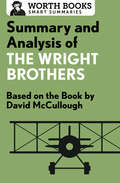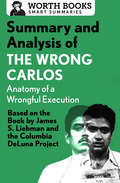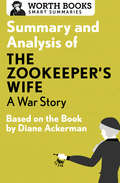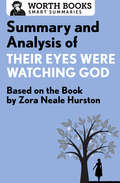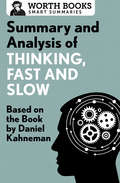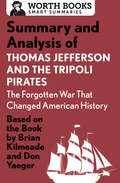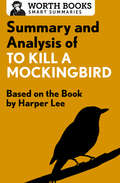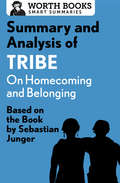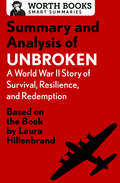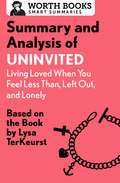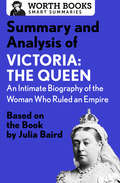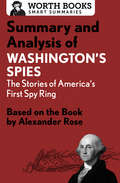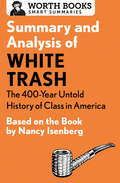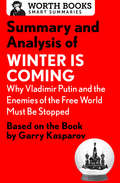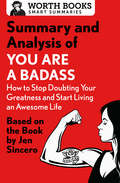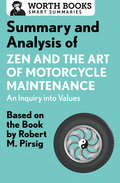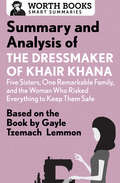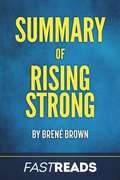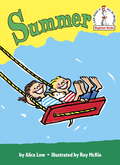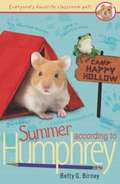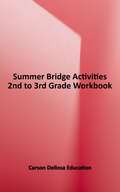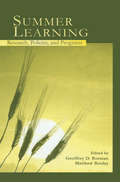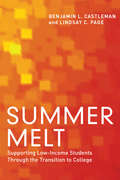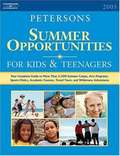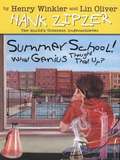- Table View
- List View
Summary and Analysis of The Wright Brothers: Based on the Book by David McCullough
by Worth BooksSo much to read, so little time? This brief overview of The Wright Brothers tells you what you need to know--before or after you read David McCullough's book. Crafted and edited with care, Worth Books set the standard for quality and give you the tools you need to be a well-informed reader. This short summary and analysis of The Wright Brothers by David McCullough includes: Historical contextChapter-by-chapter summariesDetailed timeline of key eventsImportant quotesFascinating triviaGlossary of termsSupporting material to enhance your understanding of the original work About David McCullough's The Wright Brothers: Two-time Pulitzer Prize winner David McCullough's biography is a fresh, personal account of Wilbur and Orville Wright: two young men from the American Midwest who, armed with dedication, ingenuity, and the skills they acquired as bicycle mechanics, invented the first practical airplane in history. Based on extensive research--including the brothers' personal correspondence and diaries--The Wright Brothers brings these two iconic American heroes to life as never before. More than the chronicle of an invention, The Wright Brothers is the story of an American family whose belief in the values of hard work and perseverance made all things seem possible--even the conquest of the skies. The summary and analysis in this ebook are intended to complement your reading experience and bring you closer to a great work of nonfiction.
Summary and Analysis of The Wrong Carlos: Based on the Book by James S. Liebman
by Worth BooksSo much to read, so little time? This brief overview of The Wrong Carlos: Anatomy of a Wrongful Execution tells you what you need to know—before or after you read James S. Liebman and the Columbia DeLuna Project’s book. Crafted and edited with care, Worth Books set the standard for quality and give you the tools you need to be a well-informed reader. This short summary and analysis of The Wrong Carlos: Anatomy of a Wrongful Execution by James S. Liebman and the Columbia DeLuna Project includes: Historical contextChapter-by-chapter summariesDetailed timeline of important eventsImportant quotesFascinating triviaGlossary of terms About James S. Liebman and the Columbia DeLuna Project’s The Wrong Carlos: Anatomy of a Wrongful Execution: The Wrong Carlos calls into question the United States justice system and its ability to impose the death penalty with impartiality and certainty through an in-depth examination of an obscure capital murder case from the 1980s. In Corpus Christi, Texas, a man named Carlos DeLuna was executed for the murder of Wanda Vargas Lopez, while a man who looked just like him, Carlos Hernandez, escaped conviction for killing her and others. Columbia Law School professor James S. Liebman and his team from the Columbia DeLuna Project delve into this case of mistaken identity to study how factors such as race, poverty, and reliance upon eyewitness testimony can contribute to erroneous death penalty convictions. In a country where capital punishment remains controversial, The Wrong Carlos asks its readers to consider whether irreversible conviction at the hands of a flawed system is the type of justice Americans want to see served. The summary and analysis in this ebook are intended to complement your reading experience and bring you closer to a great work of nonfiction.
Summary and Analysis of The Zookeeper's Wife: Based on the Book by Diane Ackerman
by Worth BooksSo much to read, so little time? This brief overview of The Zookeeper’s Wife tells you what you need to know—before or after you read Diane Ackerman’s book. Crafted and edited with care, Worth Books set the standard for quality and give you the tools you need to be a well-informed reader. This short summary and analysis of The Zookeeper’s Wife includes: Historical contextChapter-by-chapter overviewsProfiles of the main charactersDetailed timeline of key eventsImportant quotesFascinating triviaGlossary of termsSupporting material to enhance your understanding of the original workAbout The Zookeeper’s Wife: A War Story by Diane Ackerman: The Zookeeper’s Wife is the story of two unsung heroes of World War II: Jan and Antonina Żabiński, Polish zookeepers who risked their lives to rescue Jews from death at the hands of the Nazis. The heroic couple hid more than three hundred fugitives in their home and in the empty animal cages of the Warsaw Zoo. Diane Ackerman vividly evokes the extreme brutality and heroism that defined WWII-era Poland. The Zookeeper’s Wife is a testament to the bravery of those who resisted tyranny through radical compassion. The summary and analysis in this ebook are intended to complement your reading experience and bring you closer to a great work of nonfiction.
Summary and Analysis of Their Eyes Were Watching God: Based on the Book by Zorah Neale Hurston
by Worth BooksSo much to read, so little time? This brief overview of Their Eyes Were Watching God tells you what you need to know—before or after you read Zora Neale Hurston’s book. Crafted and edited with care, Worth Books set the standard for quality and give you the tools you need to be a well-informed reader. This short summary and analysis of Their Eyes Were Watching God includes: Historical contextCast of charactersChapter-by-chapter overviewsCharacter analysisThemes and symbolsImportant quotesFascinating triviaGlossary of termsSupporting material to enhance your understanding of the original work About Their Eyes Were Watching God by Zora Neale Hurston: Their Eyes Were Watching God is storytelling at its soulful and powerful best. Published nearly a century ago, this classic novel remains unequivocally woven into the fabric of our country’s rich African American heritage, culture, and history. A passionate tribute to the strength and perseverance of the human heart, Zora Neale Hurston’s tale of one woman’s journey to self-actualization and unconditional love at the dawn of the twentieth century is filled with melodic voices and memorable characters, and resonates with symbolism in every chapter. The summary and analysis in this ebook are intended to complement your reading experience and bring you closer to a great work of fiction.
Summary and Analysis of Thinking, Fast and Slow: Based on the Book by Daniel Kahneman (Smart Summaries)
by Worth BooksSo much to read, so little time? This brief overview of Thinking, Fast and Slow tells you what you need to know—before or after you read Daniel Kahneman&’s book. Crafted and edited with care, Worth Books set the standard for quality and give you the tools you need to be a well-informed reader. This short summary of Thinking, Fast and Slow by Daniel Kahneman includes: Historical contextPart-by-part summariesDetailed timeline of key eventsImportant quotesFascinating triviaGlossary of termsSupporting material to enhance your understanding of the source work About Thinking, Fast and Slow by Daniel Kahneman: Nobel Prize–winning psychologist Daniel Kahneman explores the mysteries of intuition, judgment, bias, and logic in the international bestseller Thinking, Fast and Slow. His award-winning book explains the different ways people think, whether they&’re deciding how to invest their money or how to make friends. Kahneman&’s experiments in behavioral economics, in collaboration with cognitive psychologist Amos Tversky, led to a theory of two systems of thought: the fast thinking used when ducking a blow, and slow thinking that&’s better employed for making major life decisions. Applying these psychological concepts to different facets of our lives, Kahneman demonstrates how to better understand your own decision-making, and the choices made by others. The summary and analysis in this ebook are intended to complement your reading experience and bring you closer to great work of nonfiction.
Summary and Analysis of Thomas Jefferson and the Tripoli Pirates: Based on the Book by Brian Kilmeade & Don Yaeger (Smart Summaries)
by Worth BooksSo much to read, so little time? This brief overview of Thomas Jefferson and the Tripoli Pirates tells you what you need to know—before or after you read Brian Kilmeade and Don Yaeger&’s book. Crafted and edited with care, Worth Books set the standard for quality and give you the tools you need to be a well-informed reader. This short summary and analysis of Thomas Jefferson and the Tripoli Pirates by Brian Kilmeade and Don Yaeger includes: Historical contextChapter-by-chapter summariesImportant quotesFascinating triviaGlossary of termsSupporting material to enhance your understanding of the original workAbout Thomas Jefferson and the Tripoli Pirates by Brian Kilmeade and Don Yaeger: In 1785, US merchant ships that sailed the Mediterranean Sea began to face an unexpected threat: pirates from the North African coast. American sailors were subjected to pillage and enslavement while their government tried to negotiate tributes and ransom prices with the Islamic rulers of the Barbary nations. As the Barbary conflict intensified, Thomas Jefferson saw that negotiations could only proceed if the United States showed its military strength through a naval presence and the use of force in the Mediterranean. Jefferson committed himself to this cause as he rose to the position of secretary of state and later, president of the United States. In Thomas Jefferson and the Tripoli Pirates: The Forgotten War that Changed American History, authors Brian Kilmeade and Don Yaeger trace the exciting tale of how these kidnappings led to the First Barbary War, what transpired between the warring nations, and how Thomas Jefferson&’s decisions helped shape US policy today. The summary and analysis in this ebook are intended to complement your reading experience and bring you closer to a great work of nonfiction.
Summary and Analysis of To Kill a Mockingbird: Based on the Book by Harper Lee (Smart Summaries)
by Worth BooksSo much to read, so little time? This brief overview of To Kill a Mockingbird tells you what you need to know—before or after you read Harper Lee&’s book. Crafted and edited with care, Worth Books set the standard for quality and give you the tools you need to be a well-informed reader. This short summary and analysis of To Kill a Mockingbird by Harper Lee includes: Historical contextChapter-by-chapter summariesAnalysis of the main charactersThemes and symbolsNotes on the author&’s styleImportant quotesFascinating triviaGlossary of termsSupporting material to enhance your understanding of the original work About To Kill a Mockingbird by Harper Lee: Harper Lee&’s Pulitzer Prize–winning novel, To Kill a Mockingbird, is a beautiful and significant novel about small-town Southern society in the 1930s, where the innocence of childhood converges with the ugly realities of racial inequality. With its potent message about truth, integrity, and the moral imperative to stand up for what&’s right, To Kill a Mockingbird has earned its place in history as one of the most beloved novels of the twentieth century. The summary and analysis in this ebook are intended to complement your reading experience and bring you closer to a great work of fiction.
Summary and Analysis of Tribe: Based on the Book by Sebastian Junger (Smart Summaries)
by Worth BooksSo much to read, so little time? This brief overview of Tribe: On Homecoming and Belonging tells you what you need to know—before or after you read Sebastian Junger&’s book. Crafted and edited with care, Worth Books set the standard for quality and give you the tools you need to be a well-informed reader. This short summary and analysis of Tribe includes: Historical contextChapter-by-chapter overviewsProfiles of the main charactersDetailed timeline of key eventsImportant quotesFascinating triviaGlossary of termsSupporting material to enhance your understanding of the original work About Tribe: On Homecoming and Belonging by Sebastian Junger: Drawing on his experience as a journalist covering conflicts in Afghanistan and Sarajevo, Junger studied how war and great hardship bring people together for the common good. He speaks of combat soldiers returning home only to miss the tight bonds of their platoon, which can lead to post-traumatic stress disorder. Based on additional research into history and social science, Tribe explores how much we can learn from tribal societies and their focus on loyalty, belonging, and sacrifice, in order to appreciate the power of connectedness in the modern world. The summary and analysis in this ebook are intended to complement your reading experience and bring you closer to a great work of nonfiction.
Summary and Analysis of Unbroken: Based on the Book by Laura Hillenbrand
by Worth BooksSo much to read, so little time? This brief overview of Unbroken tells you what you need to know—before or after you read Laura Hillenbrand’s book. Crafted and edited with care, Worth Books set the standard for quality and give you the tools you need to be a well-informed reader. This short summary and analysis of Unbroken: A World War II Story of Survival, Resilience, and Redemption includes: Historical contextChapter-by-chapter overviewsDetailed timeline of eventsCharacter profilesImportant quotesFascinating triviaGlossary of termsSupporting material to enhance your understanding of the original workAbout Unbroken by Laura Hillenbrand: Louis Zamperini was a true American hero: He proudly represented the United States as a champion runner in the 1936 Olympics in Berlin, served his country as a skilled Air Corps bombardier during World War II, and survived more than a month lost at sea after his plane crashed into the Pacific Ocean—only to end up as a prisoner of war in Japan. When he was finally released, Zamperini was tormented by personal demons and wracked by post-traumatic stress disorder. After meeting evangelical minister Billy Graham, he became a born-again Christian and was able to forgive the captors who tortured him. More than a military biography, Unbroken is a timeless, engrossing, and inspiring story of bravery, endurance, and resilience. The summary and analysis in this ebook are intended to complement your reading experience and bring you closer to a great work of nonfiction.
Summary and Analysis of Uninvited: Based on the Book by Lysa TerKeurst (Smart Summaries)
by Worth BooksSo much to read, so little time? This brief overview of Uninvited tells you what you need to know—before or after you read Lysa TerKeurst&’s book. Crafted and edited with care, Worth Books set the standard for quality and give you the tools you need to be a well-informed reader. This short summary and analysis of Uninvited by Lysa TerKeurst includes: Historical contextChapter-by-chapter summariesImportant quotesFascinating triviaSelect ScripturesSupporting material to enhance your understanding of the original workAbout Uninvited by Lysa TerKeurst: Uninvited: Living Loved When You Feel Less Than, Left Out, and Lonely, by outspoken New York Times—bestselling author, wife, and mother Lysa TerKeurst, is a spiritual guide to &“living loved&” in today&’s busy, social media–driven world. The book inspires and empowers women to find the strength to overcome the pain of rejection, and to take control of their actions and feelings in order to fullyexperience God&’s love. Uninvited is an invitation to understanding, acceptance, belonging, and soulful restoration and redemption. The summary and analysis in this ebook are intended to complement your reading experience and bring you closer to a great work of nonfiction.
Summary and Analysis of Victoria: Based on the Book by Julia Baird (Smart Summaries)
by Worth BooksSo much to read, so little time? This brief overview of Victoria: The Queen tells you what you need to know—before or after you read Julia Baird&’s book. Crafted and edited with care, Worth Books set the standard for quality and gives you the tools you need to be a well-informed reader. This short summary and analysis of Victoria: The Queen includes: Historical contextChapter-by-chapter overviewsProfiles of the main charactersDetailed timeline of key eventsImportant quotesFascinating triviaGlossary of termsSupporting material to enhance your understanding of the original workAbout Victoria:The Queen by Julia Baird: Julia Baird explores and unpacks the legend of Victoria: long-reigning monarch, wife, mother, and symbol of the British Empire. Rather than contributing to the myths surrounding this fascinating and complex woman, Baird describes Victoria as she really was: passionate, strong-willed, hot-tempered, hard-working, and desperate to hold on to power and govern her nation while remaining the loyal wife to her beloved Prince Albert. Baird&’s biography takes readers through Queen Victoria&’s life and long reign, giving a clear and lucid analysis of often complex political events and relationships, as well as the personal dynamics of her household, and providing a thorough understanding of a transformative era in British history. The summary and analysis in this ebook are intended to complement your reading experience and bring you closer to a great work of nonfiction.
Summary and Analysis of Washington's Spies: Based on the Book by Alexander Rose
by Worth BooksSo much to read, so little time? This brief overview of Washington’s Spies tells you what you need to know—before or after you read Alexander Rose’s book. Crafted and edited with care, Worth Books set the standard for quality and give you the tools you need to be a well-informed reader. This short summary and analysis of Washington’s Spies includes: Historical contextChapter-by-chapter overviewsProfiles of the main charactersDetailed timeline of key eventsImportant quotesFascinating triviaGlossary of termsSupporting material to enhance your understanding of the original work About Washington’s Spies: The Story of America’s First Spy Ring by Alexander Rose: Alexander Rose’s New York Times–bestselling book Washington’s Spies offers an in-depth account of the network of men who operated covertly under George Washington’s command during the Revolutionary War. These men, referred to as the Culper Ring, worked largely in southern New York, sending and receiving coded messages from across Manhattan to Long Island, and getting crucial British intelligence to General Washington. Rose delves into the varied personalities and motivations of the Culper Ring, explores the espionage techniques of the time, including encryption and the use of invisible ink, and describes the differences in the British and American methods of gathering intelligence. Washington’s Spies inspired the television series Turn, with author Alexander Rose serving as a historical consultant and producer. The summary and analysis in this ebook are intended to complement your reading experience and bring you closer to a great work of nonfiction.
Summary and Analysis of White Trash: Based on the Book by Nancy Isenberg (Smart Summaries)
by Worth BooksSo much to read, so little time? This brief overview of White Trash tells you what you need to know—before or after you read Nancy Isenberg&’s book. Crafted and edited with care, Worth Books set the standard for quality and give you the tools you need to be a well-informed reader. This short summary and analysis of White Trash includes: Historical contextChapter-by-chapter overviewsProfiles of the main charactersDetailed timeline of eventsImportant quotesFascinating triviaGlossary of termsSupporting material to enhance your understanding of the original work About White Trash: The 400-Year Untold History of Class in America by Nancy Isenberg: In her New York Times–bestselling book White Trash: The 400-Year Untold History of Class in America, Nancy Isenberg explores the role of poor, rural whites—white trash—in US culture and politics. Throughout its history, America has prided itself on the American Dream, where a person, regardless of class, can be whomever they want. But is social mobility a true ingredient of US society, or is it just American idealism at its best? Isenberg suggests the latter as she traces the history of the country from the first English settlements, through the Civil War, and up to present-day pop culture, examining the origins of the language and attitudes that have defined poor, white Americans for centuries. As Donald Trump moved in to the White House thanks, in part, to a vocal contingent of poor, white supporters, White Trash&’s detailed history offers insight to how the new president curried the favor of this large, often overlooked population, and how they might fare under his leadership. The summary and analysis in this ebook are intended to complement your reading experience and bring you closer to a great work of nonfiction.
Summary and Analysis of Winter Is Coming: Based on the Book by Garry Kasparov
by Worth BooksSo much to read, so little time? This brief overview of Winter Is Coming tells you what you need to know—before or after you read Garry Kasparov’s book. Crafted and edited with care, Worth Books set the standard for quality and give you the tools you need to be a well-informed reader. This short summary and analysis of Winter Is Coming includes: Historical contextChapter-by-chapter overviewsProfiles of the main charactersDetailed timeline of key eventsImportant quotesFascinating triviaGlossary of termsSupporting material to enhance your understanding of the original workAbout Winter Is Coming: Why Vladimir Putin and the Enemies of the Free World Must Be Stopped by Garry Kasparov: Winter Is Coming tells the story of Vladimir Putin’s stunning rise to power—and is a dire warning. Beginning with the fall of the Soviet Union, Russian dissident and chess champion Garry Kasparov traces the circumstances that allowed Putin to flourish, including Russia’s aborted attempt at democracy under Boris Yeltsin and the Chechen Wars. Despite Putin’s constant and ruthless assaults on civil liberties and international diplomacy—including his botched hostage negotiations in Beslan, corruption and voter fraud, the imprisonment and murders of protesters and opposition figures, and the annexation of the Crimea region in Ukraine—the West and the UN continue to acquiesce to his demands, making him stronger. Learn why Garry Kasparov likens Putin to Adolf Hitler of the 1930s and why he believes that if no one steps in to stop him, the consequences could be disastrous. The summary and analysis in this ebook are intended to complement your reading experience and bring you closer to a great work of nonfiction.
Summary and Analysis of You Are a Badass: Based on the Book by Jen Sincero
by Worth BooksSo much to read, so little time? This brief overview of You Are a Badass tells you what you need to know—before or after you read Jen Sincero’s book. Crafted and edited with care, Worth Books set the standard for quality and give you the tools you need to be a well-informed reader. This short summary and analysis of You Are a Badass by Jen Sincero includes: Chapter-by-chapter overviewsCharacter profilesImportant quotesFascinating triviaGlossary of termsSupporting material to enhance your understanding of the original work About You Are a Badass:How to Stop Doubting Your Greatness and Start Living an Awesome Life by Jen Sincero: Jen Sincero wants to help you live your best life. Hilarious and inspiring, You Are a Badass is a book for those ready to make big changes in their lives. From confronting your fears, to taking risks, to making money, to finding love, Sincero teaches how to become your own personal cheerleader—and kick butt doing it. The summary and analysis in this ebook are intended to complement your reading experience and bring you closer to a great work of nonfiction.
Summary and Analysis of Zen and the Art of Motorcycle Maintenance: Based on the Book by Robert M. Pirsig (Smart Summaries)
by Worth BooksSo much to read, so little time? This brief overview of Zen and the Art of Motorcycle Maintenance tells you what you need to know—before or after you read Robert M. Pirsig&’s book. Crafted and edited with care, Worth Books set the standard for quality and give you the tools you need to be a well-informed reader. This short summary and analysis of Zen and the Art of Motorcycle Maintenance: An Inquiry into Values includes: Historical contextChapter-by-chapter overviewsCast of charactersThemes and symbolsImportant quotesFascinating triviaGlossary of termsSupporting material to enhance your understanding of the original workAbout Zen and the Art of Motorcycle Maintenance by Robert M. Pirsig: Zen and the Art of Motorcycle Maintenance is three books in one, including the author&’s account of a transcontinental journey, his struggle to reconcile both halves of an identity fragmented by his own mental illness, and a rumination on Eastern versus Western philosophy. Now, more than forty years since its original release, Zen and the Art of Motorcycle Maintenance has become a modern classic—the kind of book that challenges readers to step outside of their everyday thoughts and consider some of life&’s most profound questions through the entertaining lens of a father-son trip. The summary and analysis in this ebook are intended to complement your reading experience and bring you closer to a great work of nonfiction.
Summary and Analysis of the Dressmaker of Khair Khana: Based on the Book by Gayle Tzemach Lemmon
by Worth BooksSo much to read, so little time? This brief overview of The Dressmaker of Khair Khana tells you what you need to know—before or after you read Gayle Tzemach Lemmon’s book. Crafted and edited with care, Worth Books set the standard for quality and give you the tools you need to be a well-informed reader. This short summary and analysis of The Dressmaker of Khair Khana: Five Sisters, One Remarkable Family, and the Woman Who Risked Everything to Keep Them Safe includes: Historical contextChapter-by-chapter overviewsProfiles of the main charactersDetailed timeline of key eventsImportant quotesFascinating triviaGlossary of termsSupporting material to enhance your understanding of the original work About The Dressmaker of Khair Khana by Gayle Tzemach Lemmon: The Dressmaker of Khair Khana is the inspiring true story of Kamila Sidiqi, a young woman who received her teaching certificate the day the Taliban entered and occupied Kabul in 1990. With ingenuity, faith, and leadership, Kamila established a garment business in her living room—employing family members and neighbors—which enabled their survival in during one of the most tumultuous decades in the region. Gayle Tzemach Lemmon tells the uplifting story of the women who, with quiet heroism, not only survived Taliban rule, but supported and protected their families and fellow Afghans. The summary and analysis in this ebook are intended to complement your reading experience and bring you closer to a great work of nonfiction.
Summary of Rising Strong
by Brene Brown FastreadsDon't miss out on the fresh perspective of bestselling author and social scientist Brené Brown in this summary of her book, "Rising Strong: The Reckoning, The Rumble, The Revolution." This FastReads Summary contains full chapter synopses, key takeaways and analysis to help you quickly understand Brown's insight and turn your own vulnerability into strength today.
Summer (Beginner Books(R))
by Roy Mckie Alice LowA boy, a girl, and a dog share the joys of summer-swimming, fishing, gardening, watching fireworks, chasing butterflies, and toasting marshmallows-in this newly recolorized backlist classic.
Summer According to Humphrey (Humphrey #6)
by Betty G. BirneyThe sixth book in the beloved and award-winning school hamster series!When Humphrey hears that school is ending, he can't believe his ears. What's a classroom hamster to do if there's no more school? It turns out that Mrs. Brisbane has planned something thrilling for Humphrey and Og the frog: they're going to Camp Happy Hollow with Ms. Mac and lots of the kids from Room 26! Camp is full of FUN-FUN-FUN new experiences, but it's also a little scary. There are fur-raising wild sounds and smells, and there's something called the Howler to watch out for. Humphrey is always curious about new adventures, but could camp be too wild even for him?Look for all twelve of Humphrey's adventures!
Summer Bridge Activities®, Grades 2 To 3 (Summer Bridge Activities Ser. #4)
by Carson Dellosa EducationAward-Winning Workbook: Summer Bridge Activities is the recipient of the 2018 Kids' Product of the Year Award and Travel Fun of the Year Award from "Creative Child Magazine." This workbook was designed to prevent summer learning loss and help your child get a headstart on the next year. Includes: One Summer Bridge Activities workbook for 2nd to 3rd grade. This workbook focuses on math, writing, reading, science, social studies, fitness, and character building. It also includes bonus stickers and flash cards. 15 Minutes A Day: These best-selling summer activity books are designed to prevent learning loss in just 15 minutes per day. Each page is numbered by day so children and parents can track progress and reach monthly learning goals. Teacher-Recommended: Summer Bridge is a teacher-recommended workbook that parents have loved and trusted for the last 10 years. Summer Bridge Activities is available for preschool through 8th grade. Support your children through the end of middle school! Summer Learning Loss: Summer learning loss is when children lose skills learned in school over the course of the summer season. Two months of learning loss occurs during the summer, with the highest losses being in math and spelling.
Summer Learning: Research, Policies, and Programs
by Geoffrey D. Borman Matthew BoulayThis book brings together up-to-date, research-based evidence concerning summer learning and provides descriptions and analyses of a range of summer school programs. The chapters present theory and data that explain both the phenomenon of summer learning loss and the potential for effective summer programs to mitigate loss and increase student achievement.Summer Learning: Research, Policies, and Programs:*presents evidence describing variations in summer learning loss and how these learning differences affect equality of educational opportunity and outcomes in the United States;*discusses the development, characteristics, and effects of the most recent wave of summer programs which are designed to play key roles in the recent standards movement and related efforts to end social promotion;*examines the impact of three of the most widespread, replicable summer school programs serving students across the United States; and*considers the characteristics and effects of alternative programs and practices that are designed to combat the problem of summer learning loss head on.Intended for education researchers, practitioners, policymakers, and graduate students, this volume is particularly relevant to those interested in social stratification, equity-minded policies, implications of the current standards movement and high stakes testing, and the development of programs and practices for improving education.
Summer Melt: Supporting Low-Income Students Through the Transition to College
by Benjamin L. Castleman Lindsay C. PageUnder increasing pressure to raise graduation rates and ensure that students leave high school college- and career-ready, many school and district leaders may believe that, when students graduate with college acceptances in hand, their work is done. But as Benjamin L. Castleman and Lindsay C. Page show, summer can be a time of significant attrition among college-intending seniors—especially those from low-income families. Anywhere from 10 to 40 percent of students presumed to be headed to college fail to matriculate at any postsecondary institution in the fall following high school.Summer Melt explores the complex factors that contribute to this trend—the absence of school support, confusion over paperwork, lack of parental guidance, and the teenage tendency to procrastinate. The authors draw on findings from fields such as neuroscience, behavioral economics, and social psychology to contextualize these factors. Drawing on a series of research studies, they show how schools and districts can develop effective, low-cost, scalable responses—including counselor outreach, peer mentoring, and using text messages and social media—to help students stay on track over the summer.Summer Melt offers very practical guidance for schools and districts committed to helping their students make the transition to college.
Summer Opportunities for Kids and Teenagers 2005
by Peterson'sEnvironmental awareness camps in Costa Rica? College-prep courses on some of America's most prestigious campuses? They're all here, and much more.
Summer School! What Genius Thought That Up? (Hank Zipzer, the World's Greatest Underachiever #8)
by Henry Winkler Lin Oliver Tim HeitzSummer school are two words in the English language that Hank Zipzer doesn't want to learn. But there's no getting out of this one for Hank-summer school, here he comes! <p> <p>Will Hank have to spend the summer bored to death inside a sweltering classroom, or will he actually learn a cool lesson or two? <p><b> Lexile Level: 760L</b></p>
